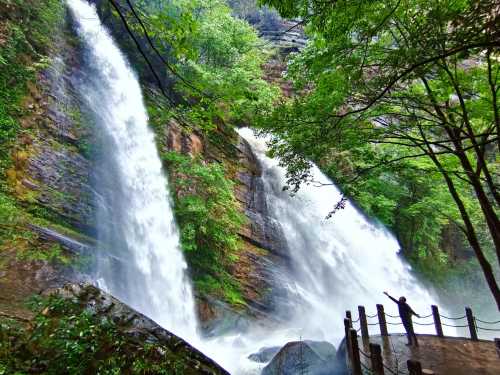Popular Trip Moments
Must-visit attractions in Hanzhong: Shimen Plank Road, Tianhan Wetland Park, Qingmuchuan Ancient Town, Shizigou Ranch. A four-day, five-night trip for two people (budget within 6,000 yuan) | The gurgling beginnings: the pulse of life at the source of the Han River | Qingmuchuan|Echoes of Time in the Ancient Border Town | 1.5 hours from Xi'an! Stay in a fairy-tale tea mountain cabin in the secret autumn tea region of southern Shaanxi! | Complete Guide to Strolling Through Qingmuchuan Ancient Town in the Mist | Step into Three Provinces with One Foot, Dreaming Back to the Ming and Qing Dynasties | Summer Business Trip? This is the Perfect Stopover Spot! | 3 Days 2 Nights Unlocking the Secrets of Qinba Mountains: 90% of Travelers Don't Know These Hidden Gems! | Qingmuchuan Ancient Town | At the junction of three provinces in Qingmuchuan, experience the real-life version of "A Lifetime of Heroes" | Exploring Qingmuchuan: The Legendary Ancient Town in the Hidden Gem of Southern Shaanxi | "Hanzhong Panda Music Festival Draws Massive Crowds!" | 【Top 9 Must-Visit Attractions in Hanzhong|Follow This Checklist to Explore the Hidden Gem of Han & Three Kingdoms Era】
Hanzhong is full of surprises! From the tranquil charm of ancient towns to | Unlock the Secret of Southern Shaanxi This Weekend|2 Days 1 Night Slow Time Trip to Qingmuchuan | Introduction to Qiang Culture in Ningqiang | Secrets of the Border Towns of Shaanxi, Gansu, and Sichuan: 48 Hours in Qingmuchuan, Sleeping Under the Starry River in Ming and Qing Dynasty Old Houses | Shaanxi's "Little Wuzhen" Guide | Encounter the Southern Shaanxi Water Town! Qingmuchuan Ancient Town 2 Days 1 Night Slow Travel Guide | Our lives should be spent right here—just 1.5 hours from Xi'an | Shaanxi Qingmuchuan | Spring Ancient Town Tour Guide for June to July | Qingmuchuan | The Ultimate One-Day Travel Guide to Qingmuchuan | Ningqiang Qingmuchuan Ancient Town | Stay in a Century-Old Heritage Homestay | Qingmuchuan Ancient Town|I Found the Ideal Slow Life | Qinba Mountains, the source of the Han River, I found a hidden treasure homestay away from the world | June in Hanzhong, Shaanxi, 25℃ in the Qinba Secret Realm Early Summer | Qu Family Courtyard | A Hidden Gem Homestay in Qingmuchuan Ancient Town, Southern Shaanxi | 50 Stunning Homestays Deep in the Qinling Mountains: Qu Family Courtyard | Second visit to Qingmuchuan! The mountain-view antique mansion by the tea garden is super chill | Just 1.5 hours by high-speed rail from Xi'an, a tea mountain homestay! So delightful! | Qingmuchuan Ancient Town in Hanzhong | The crowing of a rooster startles three provinces | The scenery on both sides of the river in Hanzhong is as beautiful as a painting
Recommended Attractions at Popular Destinations
Popular Attractions in Bangkok | Popular Attractions in Kuala Lumpur | Popular Attractions in Dubai | Popular Attractions in Chefchaouene | Popular Attractions in Kyoto | Popular Attractions in Los Angeles | Popular Attractions in Bali | Popular Attractions in Shanghai | Popular Attractions in Iguazu National Park(Argentina) | Popular Attractions in New York | Popular Attractions in Paris | Popular Attractions in Walt Disney World Resort | Popular Attractions in Melbourne | Popular Attractions in London | Popular Attractions in Singapore | Popular Attractions in Beijing | Popular Attractions in Las Vegas | Popular Attractions in Rome | Popular Attractions in Zanzibar Island | Popular Attractions in Sydney | Popular Attractions in West Lake | Popular Attractions in Osaka | Popular Attractions in Tokyo | Popular Attractions in Phuket | Popular Attractions in Barcelona | Popular Attractions in Madrid | Popular Attractions in Chengdu | Popular Attractions in Florence | Popular Attractions in Istanbul | Popular Attractions in Jungfrau Region
Popular Restaurants in Ningqiang
ZHENG HUA DAN GUO YU | Qianxizizhushuankao (ningqiang) | 魏家木桶鱼 | 金源山庄(G108店) | 古镇木桶鱼 | 丰谷园(羌州中路店) | 回龙烤鱼(青木川店) | 大东家火锅 | 王辉木碳烧烤(体育场店) | 味道江湖 | 老陕biangbiang面 | 古镇农家工夫柴火鸡·木桶鱼(回龙场老街店) | 宁强何家中餐店 | 东北烤肉 | 来一碗面庄(桃心岛店) | 来运小馆 | 宁强服务区-餐饮区 | Fuxinglaohao | 华莱士·全鸡汉堡(宁强汉源店) | 老成都川菜木桶鱼 | 宁强陌上餐土菜客栈 | JING WU JUE WEI YA BO | GU QIAO GA FEI | 古镇鱼乡 | 长寿老妈砂锅串串香(宁强店) | Da'angenmianjiao | 重庆巴爷香辣鸡煲·欢辣虾(体育场店) | 顶好蛋糕(西街口店) | 正新鸡排·炸鸡烧烤(宁强店) | 旺旺川菜馆
Popular Ranked Lists
Top 50 Must-Visit Restaurants in Chaozhou | Top 50 Must-Visit Restaurants in Ho Chi Minh City | Top 10 Trending Attractions in Luoyang | Popular Premium Hotels in Bowness-on-Windermere | Popular Premium Hotels in Llandderfel | Popular Premium Hotels in Altea | Popular Premium Hotels in Shirdi | Top 10 Trending Attractions in Bangkok | Popular Premium Hotels in Shan | Popular Trending Attractions in Toyako | Popular Trending Attractions in Wuyuan | Top 50 Must-Visit Restaurants in Hangzhou | Popular Premium Hotels in Chattanooga | Popular Trending Attractions in Phuket | Top 20 Trending Attractions in Wuhan | Top 50 Must-Visit Restaurants in Bruges | Top 50 Must-Visit Restaurants in Sanya | Popular Premium Hotels in Suffolk Park | Popular Trending Attractions in Luanchuan | Top 50 Luxury Hotels near Sichon | Top 50 Must-Visit Restaurants in Sydney | Popular Premium Hotels in Nakhon Pathom Province | Top 50 Must-Visit Restaurants in George Town | Popular Premium Hotels in Pokolbin | Popular Premium Hotels in Ribandar | Top 50 Must-Visit Restaurants in London | Popular Trending Attractions in Hexigten Banner | Top 50 Luxury Hotels near Mito | Top 50 Must-Visit Restaurants in Vancouver | Top 10 Trending Attractions in Yi County
About
Payment methods
Our partners
Copyright © 2025 Trip.com Travel Singapore Pte. Ltd. All rights reserved
Site Operator: Trip.com Travel Singapore Pte. Ltd.
Site Operator: Trip.com Travel Singapore Pte. Ltd.














